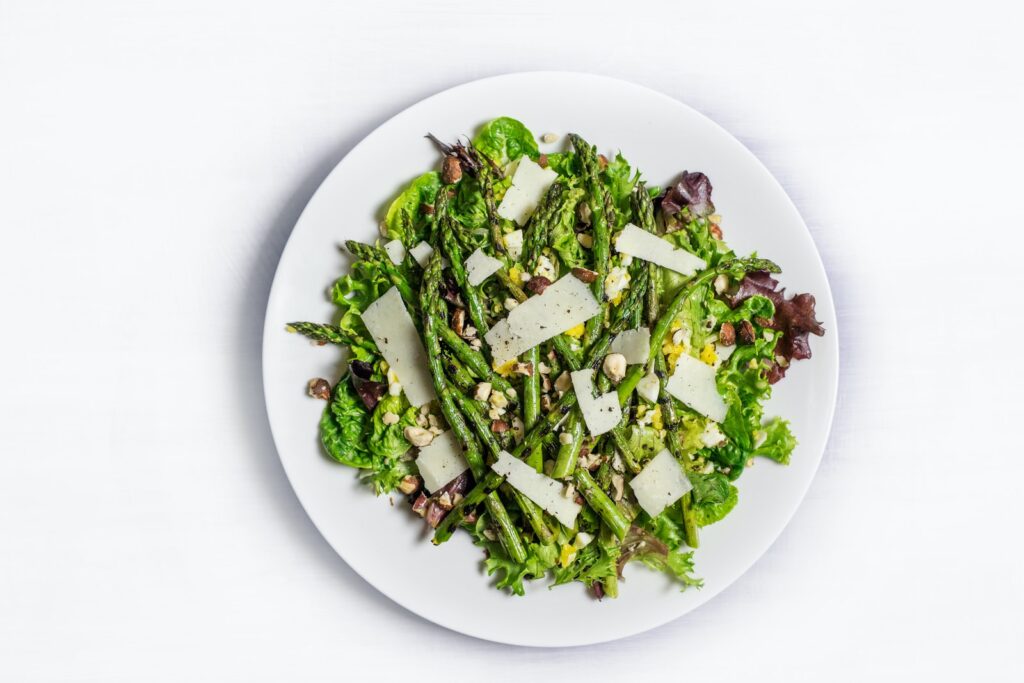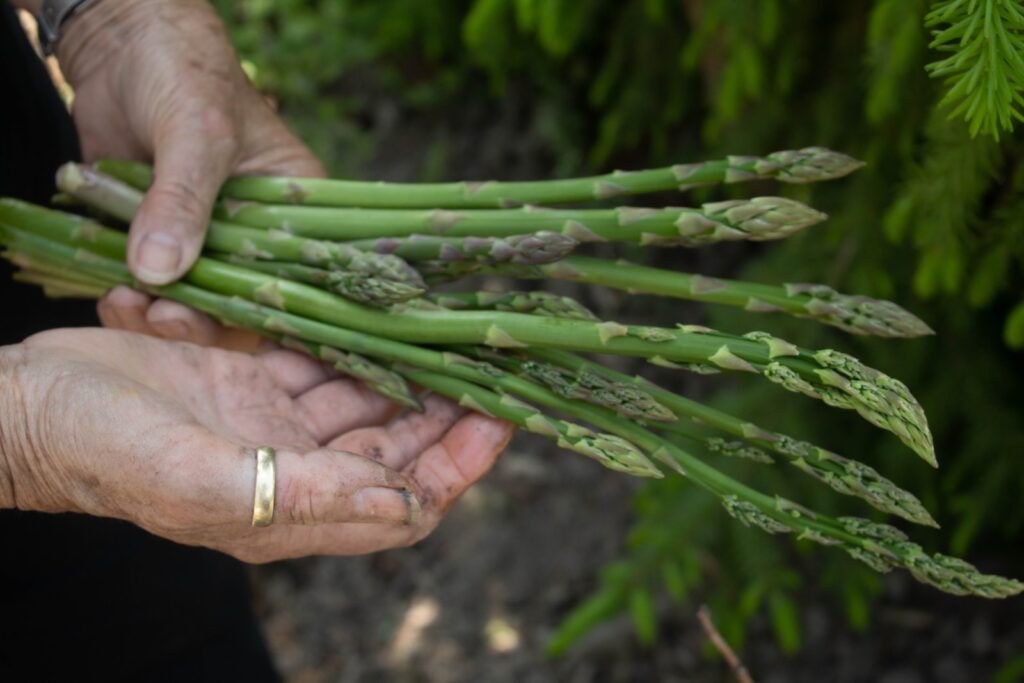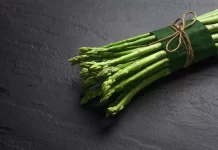Do you ever have that moment when you’re trying to decide what to eat and you get overwhelmed with all of the options? Well, that’s how I feel about asparagus. So, what does asparagus taste like must be a curious question a newbie might have.
I always have a hard time deciding what to do with it- cook it, eat it raw, make a salad, etc. So, I came up with a way to make choosing asparagus a little bit easier.
Asparagus has become a trendy food item over the last few years. But how do you know if it tastes good? It is delicious, nutritious, and has many health benefits. But how do you get your family to eat it? What makes it so special?
In this article, we’ll go over everything you need to know about Asparagus.
But why stop there? There are tons of ways to enjoy it beyond its amazing nutritional value.
On a lighter note:
Q. How asparagus is like a vampire?
A. It always seems to be sucking up all the attention.
Q. How it’s like a weed?
A. Because it grows everywhere and is hard to get rid of.
Let’s dig into it.
What Is Asparagus?
Asparagus is a member of the lily family and has been cultivated for over 2,000 years.
It grows underground and comes out above ground during springtime. The stalks grow upwards and bend at the end, giving them a spear shape.
It is one of the most popular nutritious vegetables around the world. In fact, it is considered a superfood because It is a nutrient-dense food, low in calories and fat but high in vitamins, minerals, antioxidants, fiber content, and protein.
There are many things about asparagus that make it worth eating. For starters, it is a good source of vitamins such as vitamin A, vitamin K, vitamin B9, B6, C, E, folic acid, potassium, iron, magnesium, manganese, phosphorus, selenium, sodium, and zinc. It also provides fiber, protein, and carbohydrates. And, as far as cooking goes, asparagus is easy to prepare. All you do is boil it in water for five minutes.
This veggie is often served raw, steamed, grilled, roasted, sautéed, or even pickled. If you are looking for ways to add some flavor to your meals, try adding a few spears to salads, soups, pasta dishes, or stir-fries.
What Does Asparagus Taste Like?
When it comes to asparagus, there are divided opinions on what the vegetable tastes like. Some people describe it as an earthy flavor, while others say it has a grassy taste, and yet others say it has a hint of bitterness. It is an exceptional and tasty vegetable.

In addition to that, it is a vegetable that is exceedingly fibrous and stringy. Young asparagus typically have a flavor that is more subdued, whereas older asparagus can have a taste that is a more bitter undertone. The flavor of it can change depending on its age; nevertheless, young asparagus typically have a milder delicate flavor.
When cooked, asparagus can take on a slightly sweeter flavor, but it still retains its signature earthy taste. In terms of texture, it is firm but not tough. It has a bit of a crunch to it, but should not be overcooked as this can make it mushy.
Despite its distinct taste, many people say asparagus tastes like broccoli, green beans, or artichokes. If you’ve never tried it before, we recommend giving it a try! You may be surprised by how much you enjoy its unique distinctive flavor.
Health Benefits of Asparagus
The nutrient-dense vegetable known as asparagus is associated with a wide range of positive effects on one’s health.
Asparagus, for instance, has a relatively low-calorie count and may facilitate weight loss. It has been demonstrated that eating asparagus can reduce blood pressure and enhance cardiovascular health.
In addition, it is loaded with vitamins and minerals. There is some evidence that suggests eating asparagus can help protect against certain types of cancer. Finally, there is evidence that eating asparagus can reduce the likelihood of developing depression.
- Asparagus is an excellent source of fiber which can promote regularity and help to prevent constipation.
- Folic acid in asparagus is important for pregnant women to prevent birth defects.
- It has antioxidants, which can help to protect cells from damage and may reduce the risk of some chronic diseases.
- Asparagus is an excellent source of vitamins A, C, and E, which are important for maintaining healthy skin and eyesight.
It is recommended that you add asparagus to your diet to improve your health as a whole. It can be cooked in many ways, like on the grill, in the oven, or just by steaming it. Give it a try and see for yourself how delicious and healthy it can be!
Explore Asparagus Distinct Flavor a Little More Closely
After learning a little more about asparagus, let’s chat about its unique flavor. According to what we’ve discussed previously, asparagus has a really distinct taste. Because it is a member of the Lily family. As a result, it has a natural flavor that is similar to onions, garlic, and leeks.
This flavor can be too much for some folks. Others find it to be simply delicious. You may want to start with a tiny bit of it if you aren’t sure how it tastes. You can also cook it in a wide variety of ways to help minimize its stronger flavor.
In general, it has a milder flavor when it is cooked. This is due to the fact that cooking helps to release the natural sugars in it. As a result, cooked asparagus often has a sweeter flavor than raw asparagus.
Green Asparagus
Green asparagus is the most common type of asparagus. It has a mild, slightly sweet flavor and a tender texture.

Green asparagus is typically cooked by steaming, boiling, or grilling. This green variety can also be eaten raw, as in a salad. When preparing green asparagus, it is essential not to overcook, as this will make it mushy.
Green asparagus is a versatile vegetable that can be used in a variety of dishes. Its mild flavor pairs well with other mild-tasting foods, such as chicken, fish, and pasta. This green vegetable can also be used in more assertive dishes, such as those with strong cheeses or spicy sauces.
White Asparagus
If you’re looking for a slightly sweet taste in your asparagus, white asparagus is a great option! This type of asparagus is grown in the dark, which is why it’s white in color.

White asparagus is also more tender in texture, with larger spears (both in terms of the tips and the stalks).
There are a lot of tasty foods that go well with the white variety. For example, ham, eggs, and cheese go well with this type of asparagus. It can also be used to make soups, salads, and quiches, among other things.
No matter how you choose to enjoy white asparagus, it’s a delicious and healthy option that is worth trying.
Purple Asparagus
While being the same size as green color asparagus, purple asparagus is violet in color.
The fiber, vitamins, and minerals it contains make it a nutritious choice. It also contains antioxidants that can help protect against some diseases.
Some people say that the purple variety tastes like a cross between asparagus and blueberries, sweet with a slightly grassy flavor. If you’re looking to add a pop of color to your plate, then purple asparagus is a great way to do it.
How To Store Asparagus: 4 Great Ways

Assuming you are asking about the different ways you can store asparagus, here are a few options:
Asparagus can be stored in a number of ways, depending on how you plan to use it.
- In the fridge: If you want to keep it fresh for cooking, you can store it in the refrigerator. You can store it in the fridge for up to a week. Just make sure to wrap the asparagus in a damp paper towel before placing it in the crisper drawer of the fridge.
- In a vase: You can also store asparagus in a vase filled with water. Just remember to change the water every few days.
- In the freezer: If you want to store asparagus for longer periods of time, you can blanch it and freeze it. To blanch asparagus, simply cook it in boiling water for a few minutes. Then, plunge it into ice-cold water to stop the cooking process. Once it is cooled, drain it well and place it in a freezer bag. It will keep in the freezer for up to six months.
- Pickle it: You can also pickle asparagus, which is a great way to add flavor to it. To pickle asparagus, simply cook it in vinegar and water for a few minutes. Then, store it in a glass jar in the refrigerator. It will keep for several weeks.
No matter how you plan to store it, be sure to wash it well before you use it.
How Can You Tell If the Asparagus You Bought Is Bad?
If you’re not sure how to tell if the asparagus you bought is bad, here are a few tips:
- Mold or discoloration: Check the asparagus for any signs of mold or discoloration. If you see any, it’s best to throw them out.
- Off-putting smell: Smell the asparagus. If it smells sour or rotten, it’s probably bad.
- Mushy and softer texture: Feel the asparagus. If it’s slimy or mushy, it’s probably bad.
- If you’re still not sure, you can always cook a small amount of asparagus and taste it. If it tastes bad, it’s probably bad.
How Do I Select And Buy Asparagus?
When you are at the store, there are a few things you should look for when picking out asparagus. When selecting asparagus, make sure to:
Look for fresh asparagus spears that have tight tips and no brown spots or discoloration.
Check the firm stems for breaks or bends. If the stem is broken, it’s best to avoid it. You can avoid woody stems though.
Be careful when handling the spears – they can be delicate and break easily.
If buying frozen asparagus, be sure to thaw it before using it.
Following these tips will help you select and buy fresh asparagus that is of good quality. You can enjoy your fresh asparagus now!
How Is Asparagus Harvested?
Asparagus is a perennial vegetable that is typically harvested in the spring. The asparagus plant produces spears that are edible. Its plant has underground stems (called rhizomes) those store essential nutrients and produces new spears each year. As the weather warms in the spring, the asparagus spears begin to grow rapidly, reaching their full height of 3-4 feet in just a few weeks.
After growing asparagus when spears are about 6-8 inches tall, they are ready to be harvested. Harvesting asparagus is a delicate process, as the spears are very fragile and can easily be damaged.
For this reason, most asparagus is hand-picked. The asparagus spears are cut at an angle just above the soil surface, using a sharp knife or asparagus cutter.
Once it is harvested, it is immediately cooled to preserve its freshness. These raw asparagus can be stored in the refrigerator for up to a week, although it is best to consume it as soon as possible after harvest.
How To Enhance The Flavor Of Asparagus?
If you’ve ever eaten asparagus, you know that it can be a bit bland. Some people like to add salt or butter to enhance the flavor, but there are other ways to make the taste of asparagus even better. Here are a few tips on how to enhance the flavor of asparagus:
First, cook it correctly. overcooked asparagus will have a harsh and bitter taste. Undercooked asparagus will be mushy and flavorless. To check for crispiness, use a fork to snap one end of the spear.
Second, add flavors to your dish before adding the asparagus. A little butter or salt can help add depth of flavor, but if you want something more complex, consider using spices such as basil, thyme, or pepper.
Third, try marinating asparagus spears in olive oil or another type of fat. The oil will help keep it from turning gray and it will add to its flavor.
Finally, don’t forget about the butter. Butter can enhance the flavor of asparagus in a really delicious way. Just be sure not to add too much, as it can make it greasy.
How Do I Prep And Cook Asparagus For Eating?
There are actually many different ways to cook this tasty vegetable so that it is even more delicious. Here are some tips on how to cook asparagus to make it even tastier:

Roast it:
A great way to bring out the natural sweetness and flavor of asparagus is to roast it in the oven.
Simply preheat your oven to 400 degrees Fahrenheit and then place the asparagus spears on a baking sheet.
Drizzle with olive oil and season with salt and pepper.
Roast for 10-12 minutes, or until the asparagus is tender and slightly browned.
Grill it:
Another great way to improve the taste of asparagus is to grill it. Just turn your grill to medium-high heat and put the asparagus spears on the grill grates. Grill the asparagus for 5 to 7 minutes, or until it is soft and a little bit charred.
Boil it: The easiest and quickest way to prepare asparagus is by boiling it. Put the spears into a pot of water that is already boiling, and cook for three to five minutes.
Broil it: Broiling asparagus is a great way to cook it if you want to add other ingredients to the dish. Broiling is a way to cook food by putting it right over direct heat. This lets the food cook quickly and evenly, which makes it a good way to cook it. Just turn on the broiler to a high temperature and put the spears on a baking sheet. Add some olive oil and a pinch of salt and pepper to taste.
Saute it: Asparagus can be quickly and easily prepared by sautéing it in a pan. Simply place a pan on medium heat, add a little olive oil, and then add the spears. It should be cooked for 5-7 minutes, or until tender.
Steam it: Another way to cook asparagus easily is by steaming it. Just put the spears in a steamer basket and steam them for three to five minutes.
Stir-fry it: Stir-frying asparagus is a great way to cook it if you want to add other vegetables or proteins to the dish. Heat some oil in a pan over medium-high heat and then add the asparagus and any other ingredients you are using. Cook for a few minutes, or until it is tender.
To Wrap Up
In conclusion, it is up to the individual to decide what they think asparagus tastes like, as everyone’s palate is different. However, if you’re looking for a vegetable that is both nutritious and has a unique flavor, asparagus should definitely be at the top of your list!













